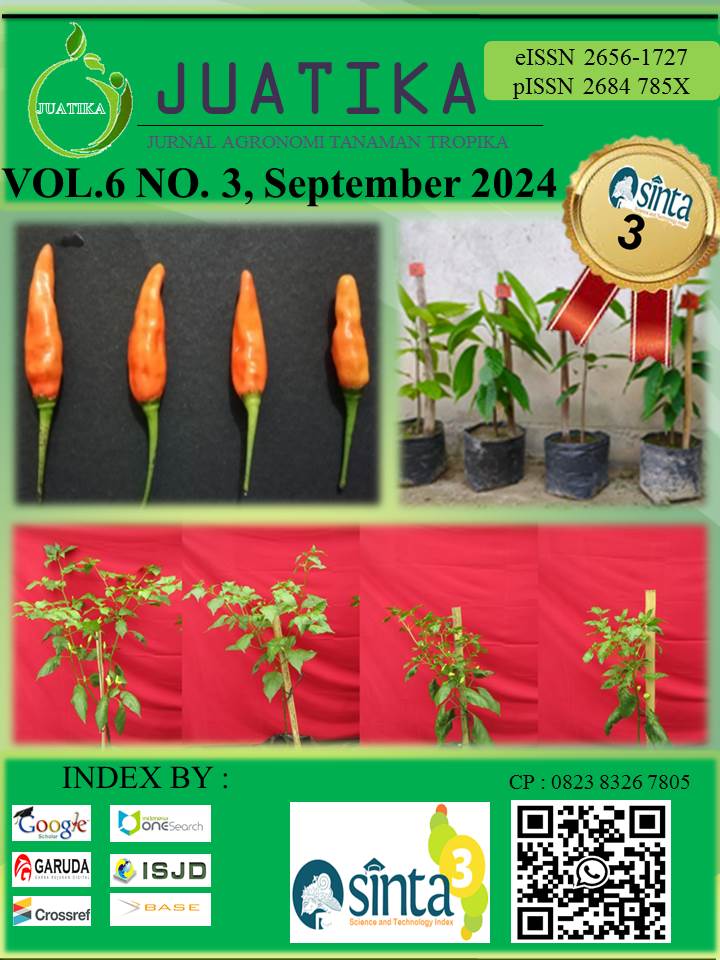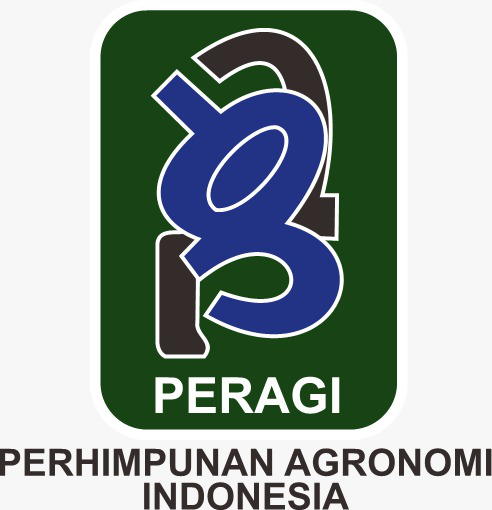Increased Growth of RED Jabon (Anthocephalus macrophyllus) Seedlings using Various Doses of Compost Fertiliser on Used Gold Mine Planting Media
Abstract
Mining operations disrupt the equilibrium of terrestrial ecosystems, leading to a decline in soil fertility and overall environmental quality. The adverse effects of such activities can severely impact forest ecosystems, resulting in disturbances to physical, chemical, and biological conditions. Consequently, initiatives aimed at restoring soil health to its pre-mining state are essential, often involving revegetation efforts. The cultivation of red jabon trees in nutrient-deficient and less fertile soils necessitates the incorporation of organic matter to enhance soil quality, typically achieved through the application of compost. This study aimed to evaluate the effects and optimal ratios of compost mixed with ex-gold mining soil on the growth of red jabon seedlings. The experimental design included four treatment groups and five replications, yielding a total of 20 experimental units. The treatments for compost application were as follows: D1 = control (no compost), D2 = 10% compost + 90% ex-gold mining soil, D3 = 30% compost + 70% ex-gold mining soil, and D4 = 50% compost + 50% ex-gold mining soil. The parameters observed included survival rate, height growth, diameter growth, dry weight of the plants, and root-to-crown ratio. The findings indicated that the application of compost significantly influenced the growth of red jabon seedlings. Notably, treatment D4 (50% compost + 50% ex-gold mining soil) yielded the most favorable results, achieving a survival rate of 100%, a height increase of 16.56 cm, a diameter increase of 2.21 mm, a dry weight of 40.73 g, and a root-to-crown ratio of 4.84.
Downloads
References
Andry, R. K., & Wawan. (2017). Pengaruh Pemberian Beberapa Dosis Pupuk Kompos (Greenbotane) Terhadap Pertumbuhan Bibit Kelapa Sawit (Elaeis Quieneensis Jacq) Di Pembibitan Utama Effect of Granting of Some Composted Fertilizer Dose (Greenbotane) on Growth of Palm Oil Palm (Elaeis Quien. Jurnal Online Mahasiswa, 4(2), 1–14.
Angraini, R., Yoza, D., & Pebriandi, P. (2024). Diversity of Soil Surface Arthropods Species in Taman Hutan Raya Sultan Syarif Hasyim, Riau Province. Jurnal Pembelajaran Dan Biologi Nukleus, 10(1), 190–206. https://doi.org/10.36987/jpbn.v10i1.5346
Asmawati, Halid, E., & Fatimah. (2015). Pengaruh pupuk kandang (kotoran ayam) terhadap pertumbuhan sambung pucuk tanaman Kakao (Theobroma cacao L.). Jurnal AgroPlantae, 4(1), 34–39.
Awaliah, A., Payung, D., & Fitriani, A. (2019). Pengaruh pemberian pupuk organik cair merek Nasa terhadap pertumbuhan bibit trembesi (Samanea Saman) di shadehouse Fakultas Kehutanan Universitas Lambung Mangkurat. Jurnal Sylva Scienteae, 02(6), 1149–1160.
Azhari, A., Oktorini, Y., Qomar, N., Volcherina Darlis, V., & Pebriandi, P. (2022). Identifikasi sifat fisik tanah inceptisol pada penggunaaan lahan (land used) di sekitar kawasan Kampus Bina Widya Universitas Riau. SYLVA: Jurnal Penelitian Ilmu-Ilmu Kehutanan , 11(2), 12–19. https://doi.org/10.32502/sylva.v11i2.5413
Bachtiar, B. (2018). Peran Media Tanam dan Pemberian Pupuk Kompos Terhadap Pertumbuhan Anakan Jabon Merah (Anthocepalus macrophyllus) di Persemaian. Bioma : Jurnal Biologi Makassar, 3(2), 10–17. https://doi.org/10.20956/bioma.v3i2.5650
Bima, M. V., Seran, W., & Mau, A. E. (2020). Pengaruh Berbagai Konsentrasi Pupuk Organik Cair (POC) Urin Sapi Terhadap Pertumbuhan Semai Kayu Putih (Melaleuca leucadendra). Jurnal Wana Lestari, 2(02), 201–211.
Darlis, V. V., Ni’mah Putriani, C., Yoza, D., & Pebriandi, P. (2023). Potensi dan pertumbuhan beberapa jenis tanaman dalam penyerapan logam berat timbal (Pb) pada media tanah bekas tambang timah Desa Siabu Kecamatan Salo Kabupaten Kampar. Journal of Tropical Silviculture, 14(03), 191–194. https://doi.org/https://doi.org/10.29244/j-siltrop.14.03.191-194
Darlis, V. V., Siahaan, H., Mardhiansyah, M., & Pebriandi, P. (2024). Pengaruh pupuk organik cair bonggol pisang terhadap pertumbuhan tanaman Tembesu (Fagraea fragrans). Jurnal Education and Development, 12(1), 333–337. https://doi.org/10.37081/ed.v12i1.5750
Hamzah, A., Yunandra, Y., & Pebriandi, P. (2020). Pemanfaatan Limbah Masyarakat dalam Pembuatan Pupuk Kompos di Desa Kuok Utilization of community waste in making compost in Kuok Village. JCSPA: Journal Of Community Services Public Affairs, 1(1), 7–10. https://doi.org/https://doi.org/10.46730/jcspa.v1i1.5
Haryadi, D., Yetti, H., & Yoseva, S. (2015). Pengaruh Pemberian Beberapa Jenis Pupuk Terhadap Pertumbuhan Dan Produksi Tanaman Kailan (Brassica alboglabra L,). Jom Faperta, 2(1), 1–10.
Henrianto, A., Okalia, D., & Mashadi, M. (2019). Uji Beberapa Sifat Fisika Tanah Bekas Tambang Emas Tanpa Izin (Peti) Di Tiga Kecamatan Di Daratan Sepanjang Sungai Kuantan. Jurnal Agronomi Tanaman Tropika (Juatika), 1(1), 19–31. https://doi.org/10.36378/juatika.v1i1.41
Herantoro, C., Mardhiansyah, M., & Sribudiani, E. (2015). Aplikasi Kompos Batang Pisang Terhadap Pertumbuhan Semai Jabon (Anthocephalus cadamba Miq.). Jurnal Online Mahasiswa, 2(1), 1–7.
Husni, H. M. (2017). Balai Pengelolaan Hutan Wilayah Lebak dan Tangerang Dinas Lingkungan Hidup dan Kehutanan. Provinsi Banten.
Irawan, A., & Hidayah, H. N. (2016). Perbandingan Pertumbuhan Jabon merah diKabupaten Bolaang Mongondow Utara dan Minahasa Utara. Jurnal Wasian, 3(1), 39–44. https://doi.org/10.20886/jwas.v3i1.883
Kusuma, M. E. (2016). Efektifitas Pemberian Dosis Pupuk Kotoran Ternak Ayam Terhadap Produksi Rumput Brachiaria humidicola pada Pemotongan Pertama dan Kedua. Jurnal Ilmu Hewani Tropika, 4(2), 49–54.
Mardhiansyah, M., Imanto, T., Pebriandi, P., Sribudiani, E., Somadona, S., & Suhada, N. (2024). Evaluating The Physical Quality of Trembesi Seedlings (Samanea saman) in The Permanent Nursery of BPDAS Indragiri Rokan, Pekanbaru City, Riau Province. Jurnal Agronomi Tanaman Tropika (JUATIKA), 6(3). https://doi.org/10.36378/juatika.v6i3.3721
Nadira, S., Isnaeini, P. N., Salsabila, N., Anggraini, H., & Pebriandi, P. (2023). Pengadaan Tempat Sampah Sebagai Wujud Implementasi Untuk Mengurangi Lingkungan Yang Kotor. Jpmnt : Jurnal Pengabdian Masyarakat Nian Tana, 1(4), 15–21. https://doi.org/https://doi.org/10.59603/jpmnt.v1i4.110
Ningsih, W. A., Mardhiansyah, M., & Pebriandi, P. (2024). Response in Growth Geronggang (Cratoxylon arborescens Vahl. Blume) Seddling by Giving Chicken Manure. Jurnal Pembelajaran Dan Biologi Nukleus, 10(1), 132–142. https://doi.org/10.36987/jpbn.v10i1.5479
Pajri, I., Sribudiani, E., & Pebriandi, P. (2023). Karakteristik pengunjung ekowisata Hutan Pinus Bukit Candika Bangkinang, Kabupaten Kampar, Provinsi Riau. Innovative: Journal Of Social Science Research, 3(6), 8041–8051. https://doi.org/https://doi.org/10.31004/innovative.v3i6.6086
Pamayo, A. I., & Trihadiningrum, Y. (2015). Stabilisasi / Solidifikasi Timbunan Tailing Penambangan. Jurnal Teknik ITS, 5(2), 2337.
Pebriandi, P., Haliyani, R., & Mardhiansyah, M. (2023). Pengaruh Media Tanam Dan Pupuk Kotoran Ayam Terhadap Pertumbuhan Semai Meranti Merah (Shorea leprosula). Indigenous Biologi Jurnal Pendidikan Dan Sains Biologi, 6(3), 126–135. https://doi.org/10.33323/indigenous.v6i3.436
Pebriandi, P., Rusdiana, O., & Buce Saleh, M. (2021). Karakteristik sifat fisik dan kimia tanah di kawasan hutan lindung Sentajo Kabupaten Kuantan Singingi, Provinsi Riau. Jurnal Ilmu-Ilmu Kehutanan, 5(1). https://doi.org/http://dx.doi.org/10.31258/jiik.5.1.1-6
Pebriandi, P., Yoza, D., Sukmantoro, W., Darlis, V. V., Qomar, N., Mardhiansyah, M., Oktorini, Y., Sribudiani, E., Somadona, S., & Muslih, A. M. (2024). Estimation of aboveground carbon stock in PT KOJO’s forest in Riau, Indonesia. BIO Web of Conferences, 99(03), 1–7. https://doi.org/10.1051/bioconf/20249903002
Prasetyo, A., Winart, S., Zubaidah, Sulistiyono, Y., & H.E.N.C, C. (2022). Pengaruh Pupuk Organik Cair Dan Pupuk Majemuk NPK Terhadap Pertumbuhan Setek Batang Cincau Hijau. Agri Peat, 23(2), 82–95.
Puspadewi, S., Sutari, W., & Kusumiyati, K. (2016). Pengaruh konsentrasi pupuk organik cair (POC) dan dosis pupuk N, P, K terhadap pertumbuhan dan hasil tanaman jagung manis (Zea mays L. var Rugosa Bonaf) kultivar talenta. Kultivasi, 15(3), 208–216. https://doi.org/10.24198/kultivasi.v15i3.11764
Safuf, E., Thomas, A., Rombang, J. A., & Kalangi, J. I. (2015). Pengaruh Pemberian Pupuk Kompos Terhadap Pertumbuhan Bibit Jabon merah (Anthocephalus macrophyllus). Journal Information, 6(17), 1–23.
Samsudin, Nelvia, & Ariani, E. (2017). Aplikasi Trichokompos Dan Pupuk Npk Pada Bibit Kakao (Theobroma cacao L.) Di Medium Gambut. Jurnal Online Mahasiswa, 4(2), 1–11.
Sancayaningsih, R. P., & Suharno. (2013). Fungi Mikoriza Arbuskula: Potensi Teknologi Mikorizoremediasi Logam Berat dalam Rehabilitasi Lahan Tambang. Bioteknologi, 10(1), 23–34. https://doi.org/10.13057/biotek/c100104
Siregar, N., Basyuni, M., & Utomo, B. (2015). Respons pertumbuhan dan komposisi rantai panjang polyisoprenoid semai berjenis sekresi Xylocarpus granatum Koenig. terhadap salinitas. Peronema Forestry Science Journal, 4(4), 1–13.
Sittadewi, E. H. (2016). Mitigasi Lahan Terdegradasi Akibat Penambangan Melalui Revegetasi. Jurnal Sains Dan Teknologi Mitigasi Bencana, 11(2), 50–60. https://doi.org/10.29122/jstmb.v11i2.3690
Starsy, D. A., Sudjatmiko, S., & Apriyanto, E. (2020). Pengaruh ukuran media tanam organik serat buah kelapa sawit pada pertumbuhan semai bambang lanang (Michelia champaca). Jurnal Penelitian Pengelolaan Sumber Daya Alam Dan Lingkungan, 9(1), 31–40.
Sunardi, Peday, H. F. Z., & Angrianto, R. (2021). Keberhasilan Tumbuh Tanaman Rehabilitasi Di IUPHHK PT. Manokwari Mandiri Lestari Kabupaten Teluk Bintuni. Jurnal Kehutanan Papuasia, 7(2), 186–195. https://doi.org/10.46703/jurnalpapuasia.vol7.iss2.251
Tendean, M., Kaligis, D. A., . R., & Kaunang, W. B. (2017). pengaruh level pupuk bokashi kotoran ayam terhadap pertumbuhan lamtoro (Leucaena leucocephala). Zootec, 38(1), 44. https://doi.org/10.35792/zot.38.1.2018.17675
Wasis, B., & Baskara, H. (2013). Pertumbuhan semai Nyatoh ( Palaquium spp .) pada media tailing PT . Antam Unit Bisnis Pongkor pada penambahan arang tempurung kelapa dan pupuk kompos bokashi. Jurnal Silvikultur Tropika, 04(April), 1–5.
Copyright (c) 2024 Viny Volcherina Darlis, Pebriandi Pebriandi, Fini Zulpeti Anggraini, Muhammad Mardhiansyah

This work is licensed under a Creative Commons Attribution 4.0 International License.
Authors who publish with Jurnal Agronomi Tanaman Tropika (JUATIKA) agree to the following terms:
Authors retain copyright and grant the Jurnal Agronomi Tanaman Tropika (JUATIKA) right of first publication with the work simultaneously licensed under a Creative Commons Attribution License (CC BY 4.0) that allows others to share (copy and redistribute the material in any medium or format) and adapt (remix, transform, and build upon the material for any purpose, even commercially) with an acknowledgment of the work's authorship and initial publication in Jurnal Agronomi Tanaman Tropika (JUATIKA).
Authors are able to enter into separate, additional contractual arrangements for the non-exclusive distribution of the journal's published version of the work (e.g., post it to an institutional repository or publish it in a book), with an acknowledgment of its initial publication in Jurnal Agronomi Tanaman Tropika (JUATIKA). Authors are permitted and encouraged to post their work online (e.g., in institutional repositories or on their website) prior to and during the submission process, as it can lead to productive exchanges, as well as earlier and greater citation of published work.







 More Information
More Information



